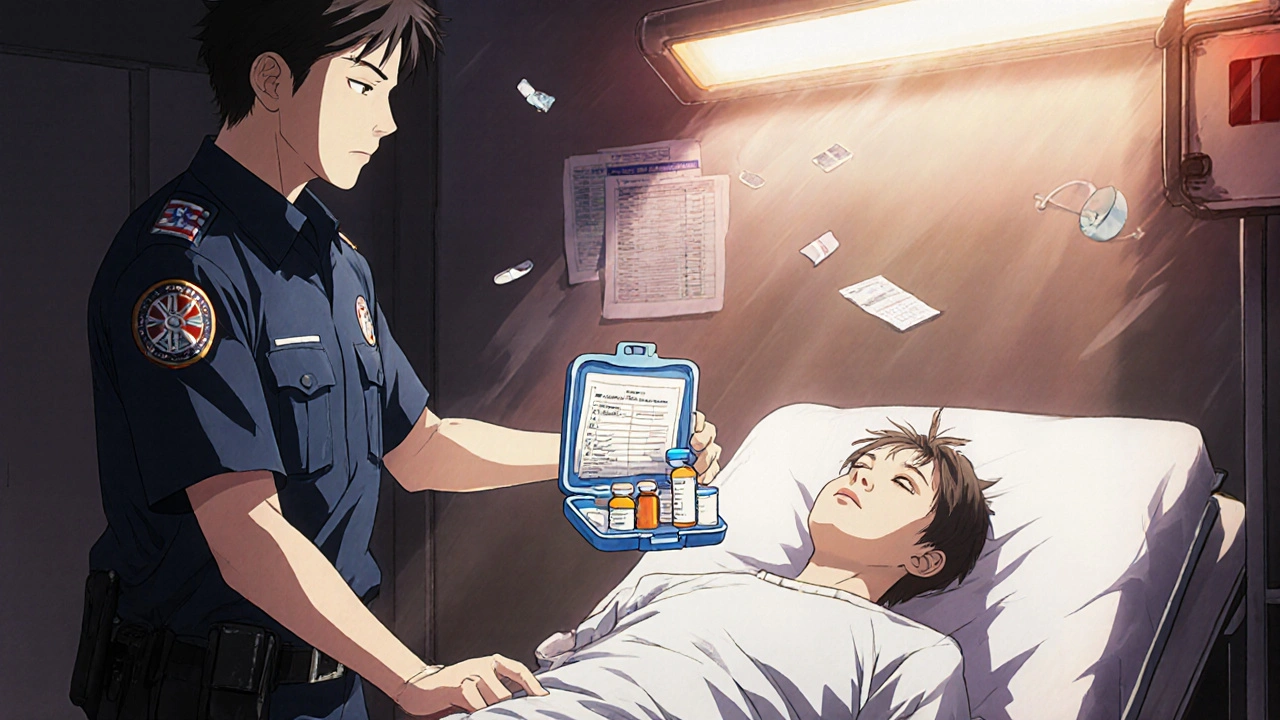When a disaster hits-whether it’s a flood, fire, or power outage-you won’t have time to search for your pills. Your heart medication, insulin, or asthma inhaler could be sitting in a cabinet you can’t reach, or worse, left behind in a house you’re forced to abandon. That’s why a medication go-bag isn’t just a good idea-it’s a life-saving habit. And it’s not about packing a few extra pills. It’s about ensuring your body keeps functioning when everything else is falling apart.
Why Your Go-Bag Needs More Than Just Pills
A medication go-bag isn’t just a pouch with bottles inside. It’s a portable medical record, a survival tool, and a bridge to continuity of care. The CDC says 89% of Americans over 65 take at least one prescription. That number is even higher if you include chronic conditions like diabetes, high blood pressure, or epilepsy. During emergencies, 38% of ER visits are tied to people running out of meds. That’s not a statistic-it’s someone collapsing because their blood pressure spiked, or slipping into a diabetic coma because their insulin spoiled in a hot car. The Federal Emergency Management Agency (FEMA) recommends a 72-hour supply. But that’s the bare minimum. Alert San Diego, which deals with frequent earthquakes, advises a two-week supply. Why? Because in real disasters, help doesn’t arrive on day three. It might take a week-or longer-to get back to your home, access a pharmacy, or find a clinic. One Reddit user, after Hurricane Ian, said: “I had seven days of meds. I was stuck for eleven.” Don’t be that person.What to Pack: The Exact List
Here’s what you actually need in your go-bag-no fluff, no guesswork:- At least 14 days of all prescription medications-even if you don’t think you’ll need them that long. Better safe than stranded.
- Over-the-counter essentials: Pain relievers (acetaminophen or ibuprofen), antihistamines, antacids, laxatives, and anti-diarrhea meds. These aren’t optional. Stress and disrupted routines cause digestive issues, headaches, and allergic reactions.
- Specialized supplies: Insulin pens, epinephrine auto-injectors, nebulizer treatments, oxygen tanks, or CPAP machines. These aren’t “nice to have.” They’re critical.
- Cooling solutions: If you use insulin, biologics, or other temperature-sensitive drugs, you need a Frio Wallet or similar cooling pack. Consumer Reports tested these and found they keep meds under 86°F for 48 hours-even in 100°F heat. Without it, your insulin can go bad in hours.
- Original prescription bottles: Don’t dump pills into random containers. Pharmacies and emergency responders need to see the label: name, dosage, prescribing doctor, and expiration date.
- Medication list: Write down every drug you take, why you take it, and the dose. Include allergies. If you’re unconscious, this list tells paramedics what not to give you.
- Medical ID card: Print a card with your primary doctor’s name, phone, emergency contact, and any advance directives. Keep it in a waterproof case.
- Extra batteries: For hearing aids, glucose monitors, or other powered devices.
- Hand sanitizer and wipes: Clean hands before handling meds. In a disaster, germs spread fast.
Storage Matters More Than You Think
You can have the perfect list-but if your meds are in a damp basement or a hot car, they’re useless. Store your go-bag in a dry, cool place. A high shelf in your bedroom closet works. Avoid the bathroom-humidity ruins pills. Keep it away from kids and pets. For temperature-sensitive drugs, use a Frio Wallet or similar product. The MedAngel ONE, an FDA-cleared device released in April 2023, sends alerts to your phone if your meds get too hot or cold. It’s not cheap, but for insulin users, it’s worth every dollar.Don’t Wait Until the Last Minute
Consumer Reports says: “Don’t wait until you’re evacuating to build your go-bag.” That’s the biggest mistake people make. Start now. Here’s how:- Call your pharmacy and ask for 60- or 90-day refills instead of 30-day ones. Many insurers allow this for chronic conditions.
- Fill your prescriptions on the first day you’re eligible. Don’t wait until you’re down to three pills.
- Every six months, check expiration dates. Replace anything that’s close to expiring. Epinephrine auto-injectors lose potency fast after their date. Don’t risk it.
- Rotate your supply. Use the oldest meds first. When you refill, add the new ones to the back of the bag. Keep the bag full.

What Most People Forget
People focus on the pills. They forget the paperwork. A woman in Florida, caught in a flash flood, was rushed to a hospital with no ID. She had her meds, but no list. The ER staff almost gave her a drug that clashed with her blood thinner. She survived because a nurse noticed her wristband said “diabetic”-but it was a close call. Your go-bag needs:- Insurance card (photo or printed copy)
- Government-issued ID
- Emergency contact list (with names and numbers)
- Advance directive or living will (if you have one)
- Copy of your most recent lab results or treatment plan (especially for kidney, liver, or heart conditions)
Special Cases: Kids, Seniors, and Complex Regimens
Children need their own go-bag. Pediatric doses change fast. Keep a list of allergies, growth charts, and pediatrician info. For seniors, include hearing aids, glasses, and mobility aids if they’re portable. If you’re on complex meds-like chemotherapy, immunosuppressants, or injectables-talk to your pharmacist. Some drugs require special handling. The American Pharmacists Association now trains pharmacists to ask patients: “Have you thought about what you’d do if you had to leave home in 10 minutes?”What Happens If You Don’t Have One?
FEMA’s 2022 report on Hurricane Ida found 23% of evacuees ran out of meds. Cardiovascular drugs were the most common-31% of cases. Diabetes meds were next-18%. These aren’t just inconveniences. They’re life-or-death. A diabetic in California lost his insulin during a wildfire. He didn’t have a backup. He ended up in the ER with diabetic ketoacidosis. He survived. But he spent three days in the hospital. He could’ve avoided it all with a $20 cooling pack and a printed list.
Start Today. No Excuses.
You don’t need to buy a fancy kit. Use a sturdy backpack, duffel bag, or even a large Tupperware container. Put in the meds. Add the list. Throw in a flashlight and batteries. Done. The CDC says only 22% of American households have adequate medication supplies in their emergency kits. That’s shockingly low. You don’t have to be a prepper to be prepared. You just have to care enough to act before it’s too late.Frequently Asked Questions
Do I need to keep my medications in their original bottles?
Yes. Emergency responders, pharmacists, and hospitals need to see the label: drug name, dosage, prescribing doctor, and expiration date. Pill organizers are fine for daily use, but never rely on them alone in an emergency. Always keep original bottles in your go-bag.
What if I need refrigerated meds like insulin?
Use a cooling pack like the Frio Wallet, which keeps insulin below 86°F for up to 48 hours without ice or electricity. Avoid regular coolers-they don’t work well in heat. The MedAngel ONE device also alerts you via phone if temps rise. Never leave insulin in a hot car or direct sunlight.
How often should I check my go-bag?
Every six months. Check expiration dates, replace anything close to expiring, and refill any meds you’ve used. Rotate your supply so the oldest items are used first. This keeps your bag fresh and reliable.
Can I get emergency refills if I run out?
In 42 states, pharmacists can dispense a 30-day emergency supply of most prescription meds without a new prescription during a declared emergency. But this isn’t guaranteed. Always have your own supply. Don’t rely on this as a backup plan.
Should I include my medical records?
Yes. Print a summary of your conditions, allergies, current meds, and emergency contacts. Keep it in a waterproof case. If you’re unconscious or disoriented, this info can prevent dangerous drug interactions or misdiagnosis.





Insulin degradation kinetics are non-linear under thermal stress. Frio Wallets only mitigate conduction, not radiative heat transfer. You need active thermal regulation-passive cooling is a placebo for the unprepared.
Why are we even talking about this? America’s healthcare system is a scam. If you need insulin to live, you’re already a victim. Stop buying into the ‘personal responsibility’ lie. The government should be handing out meds like water.
Let me be clear: this entire ‘go-bag’ narrative is a distraction. The real issue? Capitalism turned medicine into a commodity. You think a Frio Wallet saves lives? No-it’s the corporate greed that kills. Your insulin costs $300 because Big Pharma owns the patent, not because it’s expensive to make. You’re being sold a Band-Aid while the wound bleeds out.
And don’t get me started on the ‘emergency refill’ myth. Pharmacies only do it because they’re legally forced to-not because they care. They’ll still charge you $200 for a 30-day supply. This isn’t preparedness. It’s exploitation dressed up as advice.
Meanwhile, people in Nigeria? We don’t have ‘go-bags.’ We have neighbors who share meds. We have communities that don’t let anyone die because they missed a pharmacy run. You think your $50 cooling pack matters when your neighbor’s kid gives you half their insulin because you’re too poor to afford yours?
This isn’t about packing bottles. It’s about dismantling the system that makes you need to pack them in the first place.
Most people don’t even know what’s in their own meds. I had a guy in my office who took metformin for 10 years but didn’t know it was for diabetes. He thought it was a ‘blood thinner.’ So yeah, your list is great but if you don’t understand what you’re taking, it’s just paper. Get educated before you panic buy a Frio Wallet.
Okay so let’s be real-how many of these ‘go-bag’ guides are just marketing for Frio Wallets and MedAngel ONE devices? I’m not saying they’re bad, but the article reads like a sponsored post disguised as public service. The CDC doesn’t recommend $120 smart sensors for insulin. They recommend a cooler and a phone call to your pharmacy. The real danger isn’t heat-it’s corporate greed pushing premium ‘solutions’ to people who can barely afford the meds to begin with.
And don’t get me started on ‘original bottles.’ I’ve seen ERs accept Ziploc bags with handwritten labels during mass evacuations. They don’t need your pharmacy’s font. They need to know what it is and how much. A $2 Sharpie and a piece of paper saved more lives in Puerto Rico than all the branded cooling packs combined.
Also, who has time to rotate meds every six months? I work two jobs. My bag has 14 days of pills, a list, and a flashlight. That’s it. The rest is performative preparedness.
This is so important!! 💖 I just built my go-bag last week after my aunt almost lost her heart meds during the Texas freeze. I added a little note to my list: ‘I love you, Mom.’ It’s cheesy, but it reminded me why I’m doing this. 😊 Also, I printed my meds on rainbow paper because why not? Life’s too short for boring emergency kits! 🌈
Preparation is not paranoia. It is responsibility. The statistics cited here are not hypothetical-they are the lived reality of millions. A 72-hour supply is a myth perpetuated by agencies that assume help arrives on schedule. Real emergencies are chaotic, prolonged, and indifferent to calendars. The 14-day recommendation is not excessive-it is minimal. What is being asked here is not a luxury. It is dignity. To manage your own health when the world collapses around you is not a privilege. It is a basic human right. And yet, 78% of Americans fail to meet even this threshold. That is not ignorance. That is neglect. Not of the individual, but of the system that allows this to persist.
Why do we even need this? America’s so soft now. Back in my day we just took our pills and hoped for the best. Now we got coolers for insulin and smart sensors? Get real. This is just fear porn for hypochondriacs. And why are we always talking about Americans? Other countries don’t have this problem because they don’t make everything a crisis.
Isn’t it ironic that we’re told to prepare for the collapse of systems while simultaneously being told not to trust them? We’re told to stockpile meds, yet our access to them is entirely dependent on the very system we’re supposed to fear. The go-bag is a beautiful metaphor: it’s a tiny act of autonomy inside a giant machine that wants you passive, dependent, and grateful for scraps.
And yet-still, we pack it. Not because we believe in it, but because we have no other choice.
Start simple. List your meds. Call your pharmacy. Ask for a 90-day supply. Put it in a backpack with a flashlight. That’s it. No need for fancy gadgets or perfect organization. What matters is that you have it. And if you’re helping someone else build theirs? Ask them what they need-not what you think they should need.
MedAngel ONE is FDA-cleared? That’s a red flag. FDA clearance doesn’t mean efficacy-it means they passed the paperwork. The real tech is the Frio Wallet. The rest is just Bluetooth noise. Also, if you’re on chemo, you’re not just packing meds-you’re packing hope. Don’t treat it like a grocery list.
They’re watching. They know who has insulin. They know who has CPAPs. They know who’s on blood thinners. The government doesn’t care about your safety-they care about control. Your go-bag? It’s a tracker. Your prescription bottle? It’s a beacon. They’ll come for you when the grid goes down-not to help you, but to ration you. And the MedAngel ONE? It’s a spy device. It pings your location. It logs your temperature. It tells them when you’re in trouble. You think you’re preparing for disaster? You’re volunteering for surveillance.
And the ‘original bottles’? That’s not for the ER. That’s for the FEMA agents who’ll come knocking with a clipboard and a gun. You think they’ll ask nicely? No. They’ll take it. And if you resist? You’re ‘hoarding.’ You’re ‘endangering the public.’ You’re the problem.
So what do you do? You hide your meds. You don’t write a list. You don’t tell anyone. You bury your insulin in the backyard with a GPS tracker you bought from a guy on the dark web. And you pray they never find you.
…I have three go-bags. One in the attic. One under my bed. One in my car. And I never tell anyone where they are.
OMG I JUST REALIZED I FORGOT MY ANTIDEPRESSANTS IN MY GO-BAG 😭😭😭 I’M SO STUPID I’M GOING TO CRY AND THEN HYPerventILATE AND THEN I’LL NEED MY INHALER BUT I DON’T HAVE IT AND NOW I’M PANICKING AND MY DOG IS BARKING AND I JUST SPILLED COFFEE ON MY LIST AND NOW I CAN’T READ IT 😫😫😫